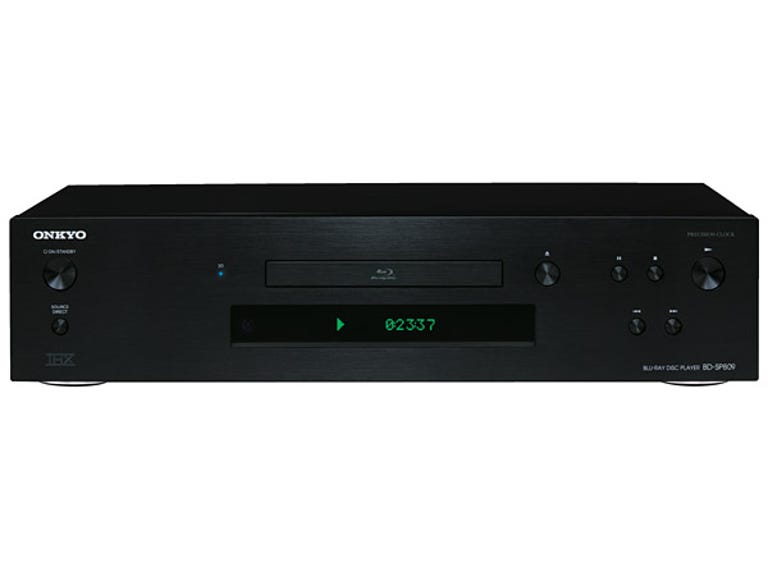 Why You Can Trust CNET
Why You Can Trust CNET Onkyo BD-SP809 Blu-ray Player review: Onkyo BD-SP809 Blu-ray Player
The Onkyo BD-SP809 is a premium Blu-ray player with solid build and good performance but a fairly limited new media feature set.
The price of the Onkyo BD-SP809 Blu-ray player would suggest that this is a premium model, and within the conventions of this product group — specialist home entertainment companies — it most certainly is. For 'premium' here doesn't mean 'feature-packed'. It means quality build, first class electronic components and the kinds of adjustments that enthusiasts like.
The Good
The Bad
The Bottom Line
Well, it certainly has the build. This is a beautifully made unit, weighing a very hefty 4.7 kilograms.
Setup
There was an interesting diversion during the setup of this player. It has two HDMI outputs, one labelled 'main' and the other 'sub'. For obvious reasons I connected the first. But I got no picture. I fiddled with various things, but no go. The settings to change the relevant HDMI output require the use of the on screen display. In the end I had to resort to using the sub output.
It was interesting because resolving the issue once again shows how modern consumer electronics devices are, basically, computers in pretty boxes. In this case, well built ones as well. It turned out that through some error this unit had the firmware for a different model installed. A 36MB download and update fixed all that. In a way, it is perhaps surprising that it worked at all previously.
Anyway, the reason for having two HDMI outputs is so that if you're using a home theatre receiver that is incompatible with 3D, you can send the audio to it using the sub output, and the picture to your 3D TV using the main.
As delivered the player supports region free DVD playback. But only Region B Blu-ray of course. This former is a kind of unofficial feature, and quite useful if you have any foreign DVDs. Occasionally with Blu-ray players new firmware versions are released, mostly to support new Blu-ray discs (the disc makers' do some strange things to their movies to try to limit piracy). The firmware installed in the player on delivery was 1.31.06. The online update is numbered 1.83.00. I don't know the numbering conventions, but that did seem like a big jump.
While I normally update firmware to the latest version before reviews, I was advised that doing so would plaster across the home screen display in huge letters the word "unofficial". Customers have a choice: stick with the old firmware, install the new firmware and get a setting change so that the unit is no longer region free for DVDs but they get a clean home screen, or upgrade with continued region free DVD support and the big unofficial. I'm informed that just about all customers go for the last. And why not? That slight air of outlawry can be fun and it doesn't interfere with operation.

(Credit: Onkyo)
Playing Discs
This was a solid, effective Blu-ray player, with some useful features for those who want the best video quality. It played all the usual discs well, and for the bulk of Blu-ray discs (those with 1080p24 video, or in 3D) the picture quality results were the same as any other decent player. Where it offered particular advantages was with interlaced discs.
A lot of players are imperfect at converting 576i50 and 1080i50 signals (from DVDs and Blu-ray discs, respectively) into high quality progressive scan signals. Those signals are foreign, after all, to most Blu-ray player engineers, who tend to be in Korea or Japan or the United States. This unit did an extremely good job of it with 1080i50, not tripping up at all on any of my most difficult test clips. With 576i50 it was reasonably good, getting a touch confused at several places on the most difficult clip. Most discs it should work with perfectly.
But here's the thing: you can set the player's output resolution to Source Direct. That is, it will switch its output resolution to match that of the signal it is playing. If you have a home theatre receiver with better progressive scan conversion, or a display that can do a better job, just select that output setting and have the external device do the work. If, that is, your display has 576i50 specified in its HDMI Extended Display Identification Data block. Not all displays do, even though they usually do support that signal standard. In that case you can change manually to 576i50 output. With DVDs you can actually change the resolution on the fly using a key on the remote. Blu-ray discs you have to stop.
The discs loaded fairly quickly. You can search for specific times and there are five fast forwards and reverse speeds. There are also three slow motion speeds and frame stepping, but these two are only in the forwards direction.
Smart Features
Network-wise, aside from the BD-Live extensions on the occasional disc, it's limited to playing a limited range of media from DLNA servers on your network. You probably won't want to use it too much, especially for music. It supports only basic formats like MP3, WMA and WAV. It will also show JPEG photos and play MPEG format video.
The USB socket supports similar media. However if you're using some advanced Blu-ray features, particularly BD-Live, you'll probably want to leave a 1GB or more USB stick in the USB socket to act as the 'Persistent Storage' sometimes required for those functions.
Conclusion
This player is the kind that goes best with a high quality system consisting largely of other Onkyo products. You're paying premium price, not so much for a large feature set, as for quality construction and very good quality video output


